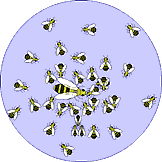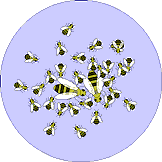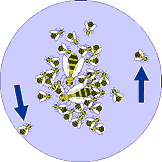Peggi
| Vocabulary | |
atomic nucleus atomic radius  effective nuclear charge  electron  period  valence electron  valence shell  |
Like swarms of bees, atoms don't really have well-defined surfaces. They're soft, diffuse objects. Electrons can be found at any distance from the nucleus. After a certain distance from the nucleus the swarm of electrons gradually thins, but never entirely disappears. However, an imaginary boundary surface can be drawn around the atom that contains (say) 99% of the electron density, and we can then refer to the size of the boundary surface as the size of the atom.
What effect does an additional electron have on atomic size? Dropping extra bees into a swarm usually makes the swarm larger: the bees each have a "personal space" that the other bees won't violate. Similarly, dropping extra electrons into an atom should cause it to swell slightly, because the electrons repel each other.
What effect does an additional proton have on atomic size? The extra proton in the atom's nucleus pulls all the inner electrons closer. The outer electrons are screened by the inner electrons, but in general they too are pulled in closer, because the inner electrons can't hide all of the additional +1 charge from those in the outer shell. So an additional proton will make the atom smaller. This is rather like dropping a queen bee into the center of a swarm. The bees are attracted to the queen, and they close in to attend her. The size of the swarm goes down, even though you've increased the mass of the swarm.
Why do atoms tend to get smaller going left to right across a period? Elements on the left side of a period have fewer electrons and protons than elements on the right side. More protons make the atom smaller; more electrons make it slightly larger. The effect of the protons wins out when the electron was added to an incomplete valence shell.

|

|
| Bees are attracted to the queen in the center of the swarm. |
Two queens attract the bees more than one, making the swarm smaller. |

|
| Additional bees can't penetrate the swarm of attendants easily. They extend the boundaries of the swarm. |
For example, both sodium and potassium have a single valence electron. The potassium atom is much larger than the sodium atom, because potassium has a larger swarm of core electrons screening the valence electron from the nucleus. The valence electron roams the outer edges of the core. All of the smaller orbitals are occupied, and the valence electron must occupy a larger orbital (with higher n). The size of the atom is effectively determined by the size of its valence shell.
For a more complete (and somewhat more technical) explanation of periodic trends in atomic size, see the notes on factors that affect the size of the valence shell.